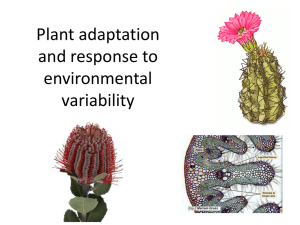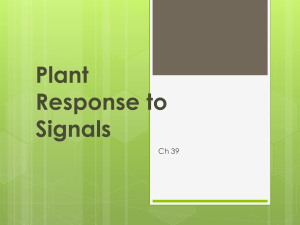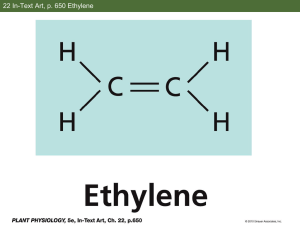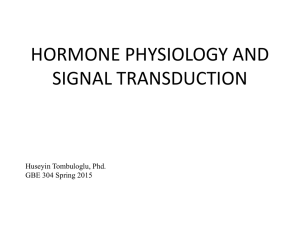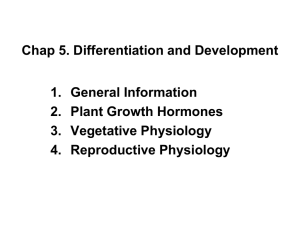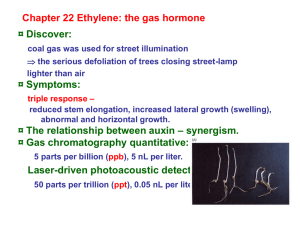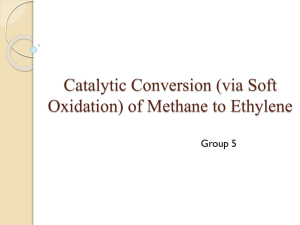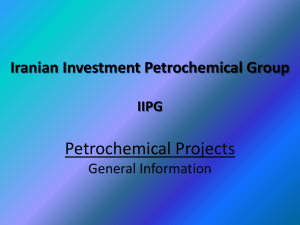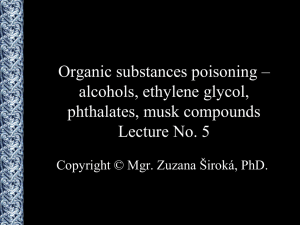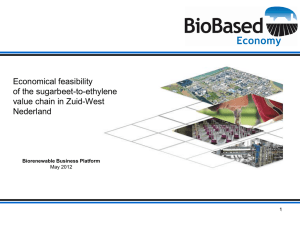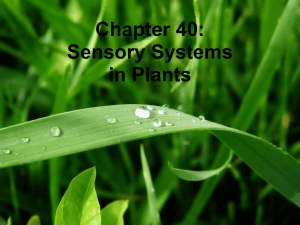Ethylene
advertisement
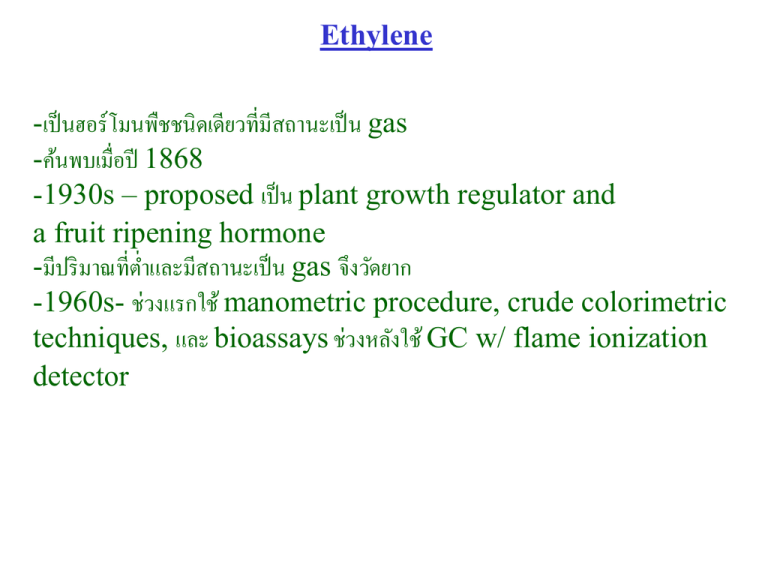
Ethylene -เป็ นฮอร์โมนพืชชนิดเดียวที่มีสถานะเป็ น gas -ค้นพบเมื่อปี 1868 -1930s – proposed เป็ น plant growth regulator and a fruit ripening hormone -มีปริ มาณที่ต่าและมีสถานะเป็ น gas จึงวัดยาก -1960s- ช่วงแรกใช้ manometric procedure, crude colorimetric techniques, และ bioassays ช่วงหลังใช้ GC w/ flame ionization detector -พบว่า พืชชั้นสู งเกือบทั้งหมดสามารถผลิต ethylene ได้ในปริ มาณที่ต่างกัน -ผลิตได้มากที่สุดใน meristematic and nodal region -เกี่ยวข้องกับการตอบสนองต่อ stress ต่าง ๆ -ปริ มาณเพิม่ ขึ้นระหว่าง leaf abscission, leaf senescence and fruit ripening -หรื อการตอบสนองต่อ stresses such as wounding, flooding, chilling, diseases, temperature and drought stress Pea seedling (6d) Triple response -inhibition of hypocotyl/epicotyl elongation -lateral enlargement of hypocotyl/epicotyl -extremely bending of the apical hook Mung bean seedling (4d) การสั งเคราะห์ Methionine (Met) SAM synthase ปัจจัยกระตุ้น -การสุ กของผลไม้ -การเสื่ อมสภาพ -การเกิดบาดแผล S-Adenosyl Methionine (SAM) ACC synthase 1-Aminocyclopropane-1-Carboxylic acid (ACC) ACC Oxidase Ethylene (C2H4) ACC synthase -Convert SAM to ACC -rate-limiting step/first committed step -first purified from tomato pericarp -induced by auxin, wounding, lithium chloride stress, and climacteric fruit ripening -encoded by multigene family -at least 6 present in tomato with 2 involving in fruit ripening -inhibitors = aminoethoxyvinyl glycine (AVG) and aminooxyacetic acid (AOA) -induced by auxin at the transcript level (using protein inhibitors) -autocatalysis (in fruit ripening process) and autoinhibition (in grapefruit flavedo) -’suicide inactivation with its substrate ((-)-SAM) ACC Oxidase -convert ACC to ethylene -formerly called ‘ethylene forming enzyme’ -activated by CO2 (one of its product) -high substrate specificity (ACC) -stereoselectivity (1-amino-2-ethylcyclopropane-1carboxylic acid (AEC) isomers) -co-factors: Fe2+, ascorbate, and O2 -Co2+ inhibits activity -extremely unstable -cDNA clone pTOM13 from tomato – increased with onset of tomato fruit ripening and after wounding of leaves Ethylene metabolism -main route = diffusion to the surrounding in gaseous form -also by oxidation to ethylene oxide and ethylene glycol -conjugate with glucose (ethylene glycol) -ACC conjugate Ethylene manipulation -two biotechnology strategies 1. Overexpression of Pseudomonas gene ACC deaminase -convert ACC to -ketobutyric acid and NH3 2. Antisense ACC oxidase or ACC synthase Ailsa tomato picked at 3 wk after onset of ripening and kept at room temp. For 3 wk pTOM13 antisense tomato -produce ~ 5% of normal amount of ethylene -fully ripen but don’t overripe and deteriorate wild type -produce normal amount of ethylene -overripe and deteriorate Ethylene inhibitors Inhibitors of ethylene biosynthesis -AVG, AOA, Co2+ Inhibitors of ethylene action -silver ions (Ag+) as silver nitrate (AgNO3) Or silver thiosulfate (Ag(S2O3)23-) -CO2 (5-10%) -trans-cyclooctane (not cis form) -1-methylcyclopropane (1-MCP) Cellular and molecular mode of ethylene action -Binding to receptor triggers signal transduction leading to cellular response -ใช้ molecular genetic studies ในการศึกษาโดยการ generate mutants ใน Arabidopsis อาศัย triple response ต่อ ethylene แบ่งได้ 2 กลุ่ม 1. ethylene-resistant or ethylene insensitive mutants (fail to respond to ethylene) 2. constitutive mutants e.g. ctr1 (constitutive triple response1) (always show ethylene response even w/ ethylene absence) Ethylene-insensitive mutants etr1 (ethylene-resistant 1) -จาก amino sequence มีลกั ษณะคล้าย bacterial two component system histidine kinase ที่ใช้สาหรับ chemo-sensory stimuli, phosphate availability, and osmolarity ใน bacteria -ดังนั้น ETR1 น่าจะเป็ น receptor สาหรับ ethylene และสามารถ bind ethylene with high affinity similar to dose-response curve -other proteins include ETR2, ERS1 (ETR1-related sequence 1), ERS2, and EIN4 -All consist of 2 domains: 1. Ethylene binding site (amino-terminal domain span mb.) 2. Histidine kinase catalytic domain -ETR1 อาจจะ located on ER และมี hydrophobic nature -คุณสมบัติน้ ีทาให้ ethylene สามารถ move freely across plasma mb. into the cell เหมือนกับ hydrophobic signaling molecules in animal cells such as steroids, and nitric oxide – bind to internal receptors -High-affinity binding of ethylene to the receptor requires copper cofactor -silver ion can substitute copper การทางานของ receptors -All receptors are encoded by multigene family -functionally redundant (shut off single gene has no effect unless all are shut off) -if all are turned offshow constitutive response to ethylene -แสดงว่า all receptors are normally ‘on’ (active) in the absence of ethylene -ดังนั้น หน้าที่ของ receptors ก็คือ ‘shut off’ the signaling pathway -ขณะเดียวกัน binding of ethylene to the receptors ‘turn off’ the receptors leading to responses to ethylene -ดังนั้น ethylene receptors act as negative regulators of the response pathways การทางานของ ethylene -Ethylene regulates gene expression via regulatory sequence called ‘ethylene response elements (EREs) -มี EIN3 เป็ น transcription factor binding to promoter ERF1 (ethylene response factor 1) ซึ่ งอยูใ่ นกลุ่ม ERE-binding proteins (EREBP) -ใช้ double mutants พบว่า CTR1 (protein kinase) act downstream of ETR1
